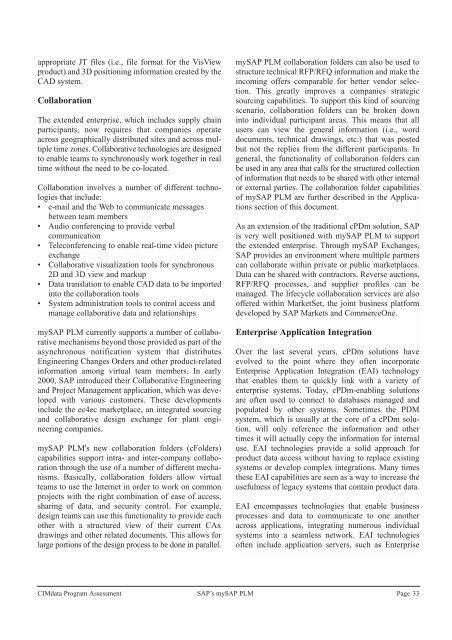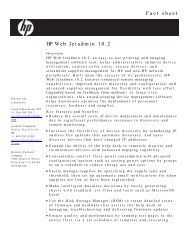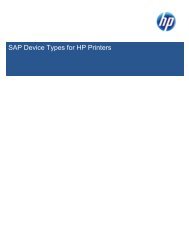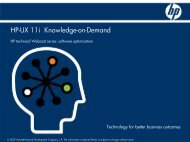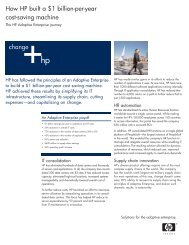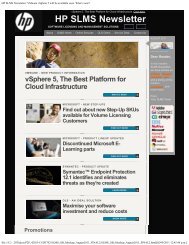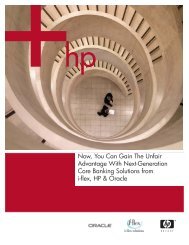CIMdata review on SAP's PLM cPDm program (PDF) - Large ...
CIMdata review on SAP's PLM cPDm program (PDF) - Large ...
CIMdata review on SAP's PLM cPDm program (PDF) - Large ...
Create successful ePaper yourself
Turn your PDF publications into a flip-book with our unique Google optimized e-Paper software.
appropriate JT files (i.e., file format for the VisView<br />
product) and 3D positi<strong>on</strong>ing informati<strong>on</strong> created by the<br />
CAD system.<br />
Collaborati<strong>on</strong><br />
The extended enterprise, which includes supply chain<br />
participants, now requires that companies operate<br />
across geographically distributed sites and across multiple<br />
time z<strong>on</strong>es. Collaborative technologies are designed<br />
to enable teams to synchr<strong>on</strong>ously work together in real<br />
time without the need to be co-located.<br />
Collaborati<strong>on</strong> involves a number of different technologies<br />
that include:<br />
• e-mail and the Web to communicate messages<br />
between team members<br />
• Audio c<strong>on</strong>ferencing to provide verbal<br />
communicati<strong>on</strong><br />
• Telec<strong>on</strong>ferencing to enable real-time video picture<br />
exchange<br />
• Collaborative visualizati<strong>on</strong> tools for synchr<strong>on</strong>ous<br />
2D and 3D view and markup<br />
• Data translati<strong>on</strong> to enable CAD data to be imported<br />
into the collaborati<strong>on</strong> tools<br />
• System administrati<strong>on</strong> tools to c<strong>on</strong>trol access and<br />
manage collaborative data and relati<strong>on</strong>ships<br />
mySAP <strong>PLM</strong> currently supports a number of collaborative<br />
mechanisms bey<strong>on</strong>d those provided as part of the<br />
asynchr<strong>on</strong>ous notificati<strong>on</strong> system that distributes<br />
Engineering Changes Orders and other product-related<br />
informati<strong>on</strong> am<strong>on</strong>g virtual team members. In early<br />
2000, SAP introduced their Collaborative Engineering<br />
and Project Management applicati<strong>on</strong>, which was developed<br />
with various customers. These developments<br />
include the ec4ec marketplace, an integrated sourcing<br />
and collaborative design exchange for plant engineering<br />
companies.<br />
mySAP <strong>PLM</strong>'s new collaborati<strong>on</strong> folders (cFolders)<br />
capabilities support intra- and inter-company collaborati<strong>on</strong><br />
through the use of a number of different mechanisms.<br />
Basically, collaborati<strong>on</strong> folders allow virtual<br />
teams to use the Internet in order to work <strong>on</strong> comm<strong>on</strong><br />
projects with the right combinati<strong>on</strong> of ease of access,<br />
sharing of data, and security c<strong>on</strong>trol. For example,<br />
design teams can use this functi<strong>on</strong>ality to provide each<br />
other with a structured view of their current CAx<br />
drawings and other related documents. This allows for<br />
large porti<strong>on</strong>s of the design process to be d<strong>on</strong>e in parallel.<br />
mySAP <strong>PLM</strong> collaborati<strong>on</strong> folders can also be used to<br />
structure technical RFP/RFQ informati<strong>on</strong> and make the<br />
incoming offers comparable for better vendor selecti<strong>on</strong>.<br />
This greatly improves a companies strategic<br />
sourcing capabilities. To support this kind of sourcing<br />
scenario, collaborati<strong>on</strong> folders can be broken down<br />
into individual participant areas. This means that all<br />
users can view the general informati<strong>on</strong> (i.e., word<br />
documents, technical drawings, etc.) that was posted<br />
but not the replies from the different participants. In<br />
general, the functi<strong>on</strong>ality of collaborati<strong>on</strong> folders can<br />
be used in any area that calls for the structured collecti<strong>on</strong><br />
of informati<strong>on</strong> that needs to be shared with other internal<br />
or external parties. The collaborati<strong>on</strong> folder capabilities<br />
of mySAP <strong>PLM</strong> are further described in the Applicati<strong>on</strong>s<br />
secti<strong>on</strong> of this document.<br />
As an extensi<strong>on</strong> of the traditi<strong>on</strong>al <strong>cPDm</strong> soluti<strong>on</strong>, SAP<br />
is very well positi<strong>on</strong>ed with mySAP <strong>PLM</strong> to support<br />
the extended enterprise. Through mySAP Exchanges,<br />
SAP provides an envir<strong>on</strong>ment where multiple partners<br />
can collaborate within private or public marketplaces.<br />
Data can be shared with c<strong>on</strong>tractors. Reverse aucti<strong>on</strong>s,<br />
RFP/RFQ processes, and supplier profiles can be<br />
managed. The lifecycle collaborati<strong>on</strong> services are also<br />
offered within MarketSet, the joint business platform<br />
developed by SAP Markets and CommerceOne.<br />
Enterprise Applicati<strong>on</strong> Integrati<strong>on</strong><br />
Over the last several years, <strong>cPDm</strong> soluti<strong>on</strong>s have<br />
evolved to the point where they often incorporate<br />
Enterprise Applicati<strong>on</strong> Integrati<strong>on</strong> (EAI) technology<br />
that enables them to quickly link with a variety of<br />
enterprise systems. Today, <strong>cPDm</strong>-enabling soluti<strong>on</strong>s<br />
are often used to c<strong>on</strong>nect to databases managed and<br />
populated by other systems. Sometimes the PDM<br />
system, which is usually at the core of a <strong>cPDm</strong> soluti<strong>on</strong>,<br />
will <strong>on</strong>ly reference the informati<strong>on</strong> and other<br />
times it will actually copy the informati<strong>on</strong> for internal<br />
use. EAI technologies provide a solid approach for<br />
product data access without having to replace existing<br />
systems or develop complex integrati<strong>on</strong>s. Many times<br />
these EAI capabilities are seen as a way to increase the<br />
usefulness of legacy systems that c<strong>on</strong>tain product data.<br />
EAI encompasses technologies that enable business<br />
processes and data to communicate to <strong>on</strong>e another<br />
across applicati<strong>on</strong>s, integrating numerous individual<br />
systems into a seamless network. EAI technologies<br />
often include applicati<strong>on</strong> servers, such as Enterprise<br />
<str<strong>on</strong>g>CIMdata</str<strong>on</strong>g> Program Assessment SAP’s mySAP <strong>PLM</strong> Page 33


